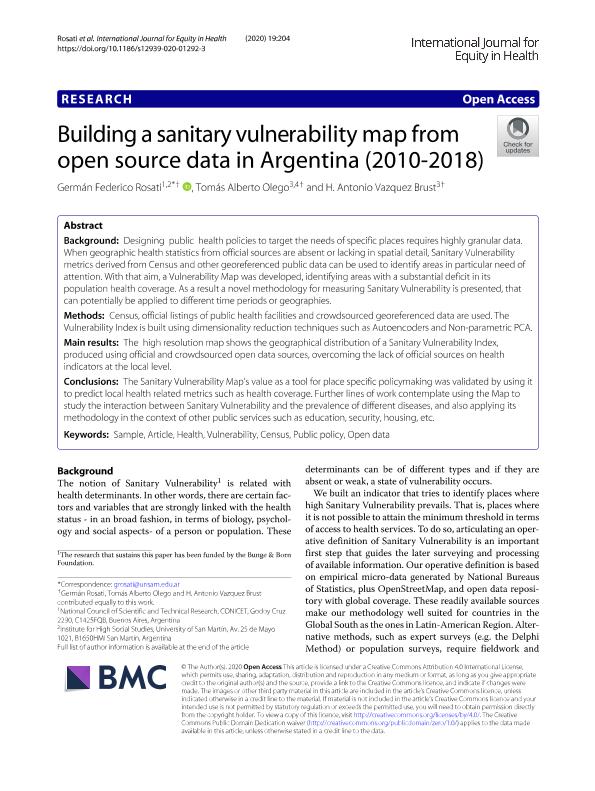Mostrar el registro sencillo del ítem
dc.contributor.author
Rosati, Germán Federico

dc.contributor.author
Olego, Tomás Alberto

dc.contributor.author
Vázquez Brust, Antonio
dc.date.available
2022-09-16T19:45:11Z
dc.date.issued
2020-09
dc.identifier.citation
Rosati, Germán Federico; Olego, Tomás Alberto; Vázquez Brust, Antonio; Building a sanitary vulnerability map from open source data in Argentina (2010-2018); BioMed Central; International Journal for Equity in Health; 19; 1; 9-2020; 1-16
dc.identifier.issn
1475-9276
dc.identifier.uri
http://hdl.handle.net/11336/169181
dc.description.abstract
Background: Designing public health policies to target the needs of specific places requires highly granular data. When geographic health statistics from official sources are absent or lacking in spatial detail, Sanitary Vulnerability metrics derived from Census and other georeferenced public data can be used to identify areas in particular need of attention. With that aim, a Vulnerability Map was developed, identifying areas with a substantial deficit in its population health coverage. As a result a novel methodology for measuring Sanitary Vulnerability is presented, that can potentially be applied to different time periods or geographies. Methods: Census, official listings of public health facilities and crowdsourced georeferenced data are used. The Vulnerability Index is built using dimensionality reduction techniques such as Autoencoders and Non-parametric PCA. Main results: The high resolution map shows the geographical distribution of a Sanitary Vulnerability Index, produced using official and crowdsourced open data sources, overcoming the lack of official sources on health indicators at the local level. Conclusions: The Sanitary Vulnerability Map’s value as a tool for place specific policymaking was validated by using it to predict local health related metrics such as health coverage. Further lines of work contemplate using the Map to study the interaction between Sanitary Vulnerability and the prevalence of different diseases, and also applying its methodology in the context of other public services such as education, security, housing, etc.
dc.format
application/pdf
dc.language.iso
eng
dc.publisher
BioMed Central

dc.rights
info:eu-repo/semantics/openAccess
dc.rights.uri
https://creativecommons.org/licenses/by/2.5/ar/
dc.subject
ARTICLE
dc.subject
CENSUS
dc.subject
HEALTH
dc.subject
OPEN DATA
dc.subject
PUBLIC POLICY
dc.subject
SAMPLE
dc.subject
VULNERABILITY
dc.subject.classification
Sociología

dc.subject.classification
Sociología

dc.subject.classification
CIENCIAS SOCIALES

dc.title
Building a sanitary vulnerability map from open source data in Argentina (2010-2018)
dc.type
info:eu-repo/semantics/article
dc.type
info:ar-repo/semantics/artículo
dc.type
info:eu-repo/semantics/publishedVersion
dc.date.updated
2022-09-15T14:55:05Z
dc.journal.volume
19
dc.journal.number
1
dc.journal.pagination
1-16
dc.journal.pais
Reino Unido

dc.journal.ciudad
Londres
dc.description.fil
Fil: Rosati, Germán Federico. Consejo Nacional de Investigaciones Científicas y Técnicas; Argentina. Universidad Nacional de San Martín. Instituto de Altos Estudios Sociales; Argentina
dc.description.fil
Fil: Olego, Tomás Alberto. Universidad de Buenos Aires. Facultad de Ciencias Sociales; Argentina. Fundacion Bunge y Born.; Argentina
dc.description.fil
Fil: Vázquez Brust, Antonio. Fundacion Bunge y Born.; Argentina
dc.journal.title
International Journal for Equity in Health
dc.relation.alternativeid
info:eu-repo/semantics/altIdentifier/url/https://equityhealthj.biomedcentral.com/articles/10.1186/s12939-020-01292-3
dc.relation.alternativeid
info:eu-repo/semantics/altIdentifier/doi/https://doi.org/10.1186/s12939-020-01292-3
Archivos asociados
